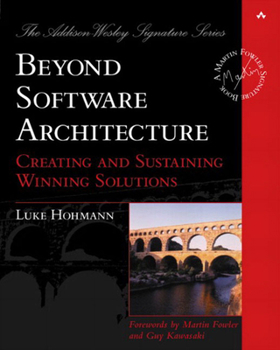Beyond Software Architecture: Creating and Sustaining Winning Solutions
(Part of the The Addison-Wesley Signature Series Series and Martin Fowler Signature Book Series)
Select Format
Select Condition 
Book Overview
At last, a book that provides the software engineering community with a clearer understanding of the business value of software architecture. There are currently a significant number of books on creating, documenting, and implementing software architecture, but precious few resources have addressed how to build a software architecture that aligns with a customer's overall business goals. In this new book, Luke Hohmann borrows from his extensive experience managing successful enterprise software projects to provide practical wisdom on creating and sustaining winning software solutions. This book helps technologists grasp the business ramifications of their decisions, and provides business-oriented software professionals (e.g. sales people and marketers) with better knowledge of how robust software can be built and maintained.
Related Subjects
Computer Design Computer Science Computers Computers & Technology Design & Architecture Education & Reference Mathematics Microprocessors & System Design Science & Math Software Software Design & Engineering Software Design, Testing & Engineering Software Development Software EngineeringCustomer Reviews
Rated 5 starsSoftware Startup 101
Beyond Software Architecture should be required reading for anyone starting a software company - that is unless one prefers the school of hard knocks! Luke does a fabulous job of going beyond the many books written on software and technology and beyond the many books, classes, and seminars addressing how to create a successful startup and get funded. Hohmann's keen insight and practical advice can make an enormous difference...
0Report
Rated 5 starsDepicts the Development Process in its fullness
There must be hundreds of books on the software developmental process, but I have yet to see a book that covers the business, technical marketing, sales cycle, deployment cycle, release cycle, licensing, installation, upgrade cycle, and everything in the middle all in one compact book. This book TRULY covers the life of a software application and everyone involved in it. For us techies, this book starts with what we are...
0Report
Rated 5 starsWhat transforms great architectures into great products?
By exposing the many practical connections between business and technical architecture, this terrific book illuminates in lucid detail how software products can transcend code to become successful solutions. It should be required reading for architects and product managers alike working on any software-related product. Many technical architects master (or at least aspire to master) technical construction, abstract design patterns...
0Report
Rated 5 starsBeyond Everyday Architecture Issues
This book delivers on its promise to discuss the larger business realities of creating software products. If you're a software architect, or dream of being one, this is a must read book. Appropriately, it eschews the details of implementation, and focuses mainly on the business issues an architect must focus on to succeed. It works from the assumption that the reader has done a fair bit of design work, and now wants to create...
0Report
Rated 5 starsBeyond Everyday Architecture Issues
This book delivers on its promise to discuss the larger business realities of creating software products. If you're a software architect, or dream of being one, this is a must read book. Appropriately, it eschews the details of implementation, and focuses mainly on the business issues an architect must focus on to succeed. It works from the assumption that the reader has done a fair bit of design work, and now wants to...
0Report













